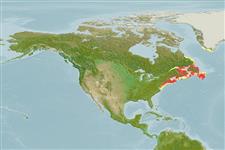Environment: milieu / climate zone / depth range / distribution range
Ecology
Marine; brackish; demersal; depth range 0 - 73 m (Ref. 57178). Temperate; 62°N - 35°N, 82°W - 3°W (Ref. 57356)
Northwest Atlantic: southern Delaware north to Labrador.
Length at first maturity / Size / Weight / Age
Maturity: Lm 9.0, range 7 - ? cm
Max length : 23.5 cm TL male/unsexed; (Ref. 5951)
Short description
Identification keys | Morphology | Morphometrics
Found in shallow coastal waters as well as in protected bays and estuaries (Ref. 10198). Occurs in large schools and burrows in the sand at times to a depth of several inches. Feeds primarily on copepods (Ref. 27549).
Nizinski, M.S., B.B. Collette and B.B. Washington, 1990. Separation of two species of sand lances, Ammodytes americanus and A. dubius, in the western North Atlantic. Fish. Bull. 88:241-255. (Ref. 10198)
IUCN Red List Status (Ref. 130435: Version 2024-2)
Threat to humans
Harmless
Human uses
Fisheries: of potential interest
Tools
Special reports
Download XML
Internet sources
Estimates based on models
Preferred temperature (Ref.
123201): 2.7 - 14.2, mean 7.9 °C (based on 128 cells).
Phylogenetic diversity index (Ref.
82804): PD
50 = 0.5156 [Uniqueness, from 0.5 = low to 2.0 = high].
Bayesian length-weight: a=0.00209 (0.00125 - 0.00348), b=3.14 (3.00 - 3.28), in cm total length, based on LWR estimates for this species & Genus-body shape (Ref.
93245).
Trophic level (Ref.
69278): 3.2 ±0.0 se; based on diet studies.
Generation time: 4.6 ( na - na) years. Estimated as median ln(3)/K based on 1
growth studies.
Resilience (Ref.
120179): Medium, minimum population doubling time 1.4 - 4.4 years (Preliminary K or Fecundity.).
Fishing Vulnerability (Ref.
59153): Moderate vulnerability (37 of 100).
Nutrients (Ref.
124155): Calcium = 60.3 [31.5, 129.4] mg/100g; Iron = 0.414 [0.224, 0.729] mg/100g; Protein = 19 [18, 20] %; Omega3 = 0.421 [0.214, 0.762] g/100g; Selenium = 10.4 [4.7, 22.7] μg/100g; VitaminA = 30.5 [10.1, 92.3] μg/100g; Zinc = 0.845 [0.569, 1.247] mg/100g (wet weight);
